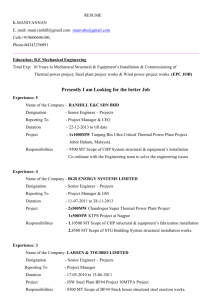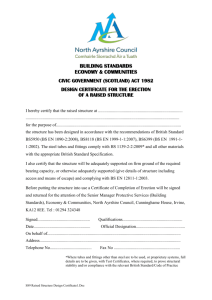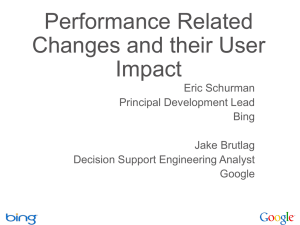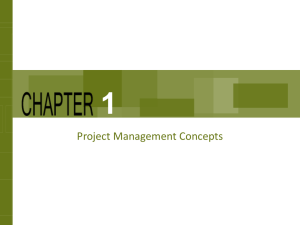A.3.8. “Project Quality Management in Construction”
advertisement
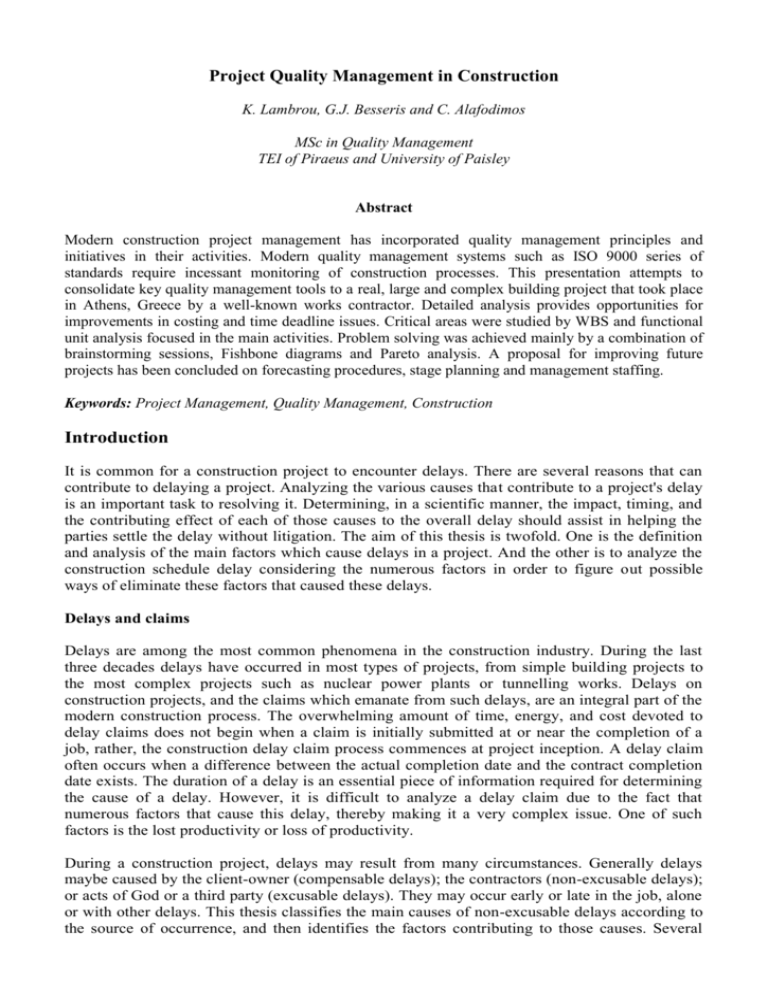
Project Quality Management in Construction K. Lambrou, G.J. Besseris and C. Alafodimos MSc in Quality Management TEI of Piraeus and University of Paisley Abstract Modern construction project management has incorporated quality management principles and initiatives in their activities. Modern quality management systems such as ISO 9000 series of standards require incessant monitoring of construction processes. This presentation attempts to consolidate key quality management tools to a real, large and complex building project that took place in Athens, Greece by a well-known works contractor. Detailed analysis provides opportunities for improvements in costing and time deadline issues. Critical areas were studied by WBS and functional unit analysis focused in the main activities. Problem solving was achieved mainly by a combination of brainstorming sessions, Fishbone diagrams and Pareto analysis. A proposal for improving future projects has been concluded on forecasting procedures, stage planning and management staffing. Keywords: Project Management, Quality Management, Construction Introduction It is common for a construction project to encounter delays. There are several reasons that can contribute to delaying a project. Analyzing the various causes that contribute to a project's delay is an important task to resolving it. Determining, in a scientific manner, the impact, timing, and the contributing effect of each of those causes to the overall delay should assist in helping the parties settle the delay without litigation. The aim of this thesis is twofold. One is the definition and analysis of the main factors which cause delays in a project. And the other is to analyze the construction schedule delay considering the numerous factors in order to figure out possible ways of eliminate these factors that caused these delays. Delays and claims Delays are among the most common phenomena in the construction industry. During the last three decades delays have occurred in most types of projects, from simple building projects to the most complex projects such as nuclear power plants or tunnelling works. Delays on construction projects, and the claims which emanate from such delays, are an integral part of the modern construction process. The overwhelming amount of time, energy, and cost devoted to delay claims does not begin when a claim is initially submitted at or near the completion of a job, rather, the construction delay claim process commences at project inception. A delay claim often occurs when a difference between the actual completion date and the contract completion date exists. The duration of a delay is an essential piece of information required for determining the cause of a delay. However, it is difficult to analyze a delay claim due to the fact that numerous factors that cause this delay, thereby making it a very complex issue. One of such factors is the lost productivity or loss of productivity. During a construction project, delays may result from many circumstances. Generally delays maybe caused by the client-owner (compensable delays); the contractors (non-excusable delays); or acts of God or a third party (excusable delays). They may occur early or late in the job, alone or with other delays. This thesis classifies the main causes of non-excusable delays according to the source of occurrence, and then identifies the factors contributing to those causes. Several studies have discussed the issues relating to these delays, but no major study has been conducted to examine the causes of non-excusable delays in great depth. Understanding the underlying factors that contribute to causes of non-excusable delays would help in identifying and overcoming the problems faced by contractors during the construction process. To assist in identifying the factors contributing to causes of non-excusable delays, the Ishikawa or fish bone diagram has been used as an analytical tool, and a ranking methodology has been devised. Negotiating a fair and timely damage settlement is beneficial to all parties. Network-based scheduling is an excellent vehicle for negotiating settlement of changes, disputes, and delays throughout the project. In the construction industry, however, there is no single, standard, and "accepted" procedure to determine the impact of schedule delays due to change orders or other unplanned developments. The construction project Construction projects are intricate, time-consuming undertakings. The total development of a project normally consists of several phases requiring a diverse range of specialized services. In progressing from initial planning to project completion, the typical job passes through successive and distinct stages that demand input from such disparate areas as financial organizations, governmental agencies, engineers, architects, lawyers, insurance and surety companies, contractors, material manufacturers and suppliers, and building tradesmen. During the construction process itself, even a structure of modest proportions involves many skills, materials, and literally hundreds of different operations. The assembly process must follow a natural order of events that constitutes a complicated pattern of individual time requirements and restrictive sequential relationships among the structure’s many segments. To some degree each construction project is unique-no two jobs are ever quite alike. In its specifics, each structure is tailored to suit its environment, arranged to perform its own particular function, and designed to reflect personal tastes and preferences. The vagaries of the construction site and the possibilities for creative and utilitarian variation of even the most standardized building product combine to make each construction project a new and different experience. The contractor sets up its “factory” on the site and, to a large extend, custom builds each structure. The construction process is subject to the influence of highly variable and sometimes unpredictable factors. The construction team, which includes architects, engineers building tradesmen, subcontractors, material dealers, and others, changes from one job to the next. All the complexities inherent in different construction sites, such as subsoil conditions, surface topography, weather, transportation, material supply, utilities and services, local subcontractors, labor conditions, and available technologies are an innate part of construction. Consequently, construction projects are typified by their complexity and diversity and by the non standardised nature of their production. The use of factory-made modular units may diminish this individuality somewhat, but it is unlikely that field construction will ever be able to adapt completely to the standardized methods and product uniformity of assembly line production. On the contrary, many manufacturing processes are moving toward “one of” production and adopting many of the project management tools originating in the construction industry. Gantt chart Also Called: milestones chart, project bar chart, activity chart. A Gantt chart is a bar chart that shows the tasks of a project, when each must take place and how long each will take. As the project progresses, bars are shaded to show which tasks have been completed. People assigned to each task also can be represented. When to Use: When scheduling and monitoring tasks within a project. When communicating plans or status of a project. When the steps of the project or process, their sequence and their duration are known. 2 When it’s not necessary to show which tasks depend on completion of previous tasks. Project management software Primavera Project Planner i. Control large and complex projects efficiently. Primavera is designed to handle largescale, highly sophisticated and multifaceted projects. To organize projects up to 100,000 activities, P3 provides unlimited resources and an unlimited number of target plans. Massive data requires sophisticated, yet highly flexible organization tools. P3 gives you a multitude of ways to organize, filter and sort activities, projects, and resources. Manage multiple projects in a multiuser environment. Large, multi-disciplined project teams. High intensity, short duration projects. Critical projects sharing limited resources. Primavera can help manage them all. It offers a single database solution (ODBCcompliant) that provides simultaneous access to project files by multiple users throughout the project; whenever and wherever required. Web features also make it easy to keep the whole team informed. Compatible with other programs in the corporation. Primavera offers impressive capability for integrating its data with information throughout the company. It supports a wide variety of data exchange formats. You can cut and paste with other Windows applications, or use Object Linking and Embedding (OLE) to link information from other applications. P3 provides true Client/Server operation for accelerated processing and SQL access for reporting on the project database. ii. iii. Quality Tools Some of the most important and most commonly used quality tools are: Plan–Do–Check–Act Cycle Fishbone Diagram Pareto Chart Scatter Diagram Decision Matrix Flowchart Stratification Control Chart Histogram Brainstorming Tree Diagram Introduction to the project Early in 1997 a large Greek petrochemical company (hereinafter referred to as "Owner") called for international tenders relating to a turn-key contract concerning the construction of a 130.000 t/y production capacity polypropylene plant in Greece (hereinafter referred to as the "Project"). Polypropylene is considered to be one of the materials of the near future and soon it is expected to replace the PVC plastic in most of its current applications. After one year of negotiations, the Owner accepted the proposal, submitted by a large construction and engineering company, specialized in constructions of petrochemical plants and refineries (hereinafter referred to as "Engineer"), for the execution of the project for a price of 83.900.000 ECU plus 9.600.000.000 GRD. Engineer invited another large domestic construction company (hereinafter referred to as 3 "Contractor") to submit, as potential subcontractor, a proposal concerning execution of the greatest portion of the construction works and certain services and supplies. Contractor submitted his proposal on March 23, 1998 and on November 23, 1998 the two companies entered into an agreement. The rest of the Works were subcontracted to another subcontractor (hereinafter referred as “Subcontractor #1”) and they were related to the assembling of the Polypropylene Spheres on site, one job which needs highly specialized constructors on the specific activity and its value didn’t ever exceed the 1.000.000.000 GDR. Although the preliminary studies made by the Owner related to the viability of its investment in the international environment were satisfied with the plant’s ability for production of 70.000 tones polypropylene per year, later more mature and detailed studies were highlighting the need for higher production, in order the product to be cheaper and more competitive both to national and international markets. The main stages of the project The Project consists of the following main disciplines of works: Civil Works Under this discipline are included all earthworks, foundations, steel structures, industrial pavings, erection of buildings, underground piping works and pits. Mechanical Works Under this discipline are included all piping works (prefabrication, erection, non destructive inspections and hydraulic or pneumatic tests), equipment erection (such as the reactor, the extruder, silos, vessels, flare, tanks, drums, compressors, valves, pumps etc.), fire fighting system, pneumatic haulage system and bagging system and the fabrication and erection of steel supports. Electrical Works Under this discipline are included all installations of power transformers, switchgears, telecommunication systems, the motor connections, the laying of cables and the erection of all the cable trays, the earthing system, the lighting system, the electric heating system etc… Instrument Works Under this discipline are included all installations of instruments, their connections and terminations, the laying of the instrument cables, the wiring in the control room, the installation of cabinets, consoles and the installation of all the control room etc… Insulation Works Under this discipline is included the cold and hot insulation of all the piping elements, equipment and instruments of the project, wherever such an instruction is given by the specifications and the drawings. Painting Works Under this discipline is included the sandblasting and painting of all the steel supports, the sandblasting of many piping spools before their erection, the painting of erected piping and equipment, wherever this is instructed through the relevant specifications and the painting of all the steel structures of the Project. Pipeline (Underground laying and offshore utilities) Under this discipline was included the inspection of the existing pipeline system from the limits of the refinery up to its sea platform (which is established 800mt from the coast), the tracing of a new pipeline, the detailed design, all the required procurement of materials and equipment and final all the construction phase. The construction phase includes the fabrication and erection of 4 one loading arm1 in a sea platform terminal - 800mt from the coast - and the interconnection with the project through a complex of valves and of one 10 inches pipeline of almost 5.500 m length, from which the 800mt are laid underwater and the rest 4.300mt are laid underground. For this part of the works only in the whole Project, Contractor in its scope of work had also the design, the procurement of all piping and equipment and the pre-commissioning and commissioning activities. In general, all works of the disciplines are separated in the following stages: The design, the procurement and delivery on the site of the materials and the equipment, the construction period, and the pre-commissioning and commissioning period. Contractor as the Main Subcontractor of the Project had in its scope of the work, only the erection activities and the procurement of all building materials, such as bricks, cement, rebars, road bitumen, a part of the steel structures, all the steel supports and cable trays and the materials for insulation and painting. All the equipment, piping, cables, instruments, the major part of the steel structures were procured and delivered on site by the Engineering company. The project for planning and progress monitoring only was divided by Engineer into the following 13 main functional units as shown below: General Area Sea Platform Sea Pipeline (and Loading Platform) Polymerization Extrusion Area Utilities Area Main Electrical Sub-station / Control Room Area Other Building (Office Building Catalyst Storage) Spheres Area Interconnecting Pipe racks (ISBL Area) Interconnecting Pipe racks (OSBL Area) Warehouse / Silos / Bagging Area Underground Area For someone not familiar with the petrochemical and in general the industrial construction activities, it should be remarked here that the ordinary series of activities between the main categories of the activities are the following: Mobilization on site, Excavations Concrete Foundations for the Steel Structures and construction of other buildings, like Electrical Substation, Control Room, Administration Buildings, Warehouses etc. The steel structures which include interconnecting pipe racks or buildings on which they will be seated the equipment. Prefabrication of large bore Piping (pipes with more than 2 inches diameter). Erection of Equipment. Cable Trays erection. Fabrication and erection of pipe supports. 5 Erection of large bore piping. Erection of small bore piping (pipes with equal or less than 2 inches diameter) and erection of additional supports. Laying of electrical cables. Laying of instrument cables. Installation of Junction Boxes, DCS, Cabinets, erection of instruments, wiring on control room etc. Connections and terminations of cables. Hydraulic and Pneumatic tests of piping and final reinstatement of all pipe lines and of all the instruments connected on them. Critical Activities Not all of the above activities are critical for the start of the posterior activities. But for instance the erection of the main steel structures is essential for the start of the rest of the activities. All the pipes (small and large bore) are connected with some kind of equipment, like a vessel, a compressor, a pump, the reactor, the extruder etc. Notwithstanding to what is expected, the installation of the equipment is not crucial for the fabrication or even the erection of the large bore pipes because the location of the large bore pipes on site is in accordance to the drawings and not with the final position of the equipment and it is not required in any specification the prior installation of the equipment, on the contrary the small bore pipes have to be located after the installation of the equipment, because their exact position and alignment with the equipment (especially with those having rotary parts, such as the pumps and the compressors) and it has always to be checked in the field prior to their erection. Furthermore, there are dozens of other similar prerequisites that an experienced project management and planning team should have taken into account during the issue of the planning schedule of the project and follow closely during the whole construction phase. It should be noticed here also the following: that each area of the plant was discrete from the others (with the exception of the interconnecting pipe racks, which they were covering parts of all the areas of the Project) and the activities that were taking place in one area were not critical for the start of the activities in another area until the mechanical completion of the works. Coclusions: Problems that created delays and disruption to the progress of the works. Premature start of pre-commissioning and commissioning activities had detrimental consequences and caused extensive delay and disruption to Contractor’s works: Engineer was working concurrently in the same area with Contractor. Engineer was drawing on Contractor’s resources to assist Engineer in its premature activities. Engineer had forced Contractor’s attention to support Engineer in clearing minor defects related to pre-commissioning and commissioning activities instead of Contractor concentrating its efforts on achieving the overall Mechanical Completion, which was Contractor’s primary and preceding contractual obligation. The earlier commencement of Engineer’s pre-commissioning and commissioning activities unveiled numerous problems in Engineer’s engineering that led to instructions 6 for changes, even to tested sections of Works. Engineer’s Commissioning Team as well as other subcontractors employed by Engineer for commissioning purposes caused extensive damages to Contractor’s completed works. In many instances these works had not yet been handed-over to Engineer, increasing Contractor’s rework. Furthermore, extensive modifications were executed to Contractor’s completed works by Engineer’s commissioning team and other subcontractors, without notice to Contractor and without its consent. The lack of communication prevailing between Engineer’s construction and commissioning departments resulted in conflicting instructions being issued to Contractor. 120.000 600 100.000 500 80.000 400 60.000 300 40.000 200 20.000 100 HOURS PERSONS G SE P O C T N O V D J A EC N 20 00 FE B M A R AP R M A Y JU L AU JU N D FE B M A R AP R M A Y 0 EC 1 JA 9 9 8 N 19 99 0 PERSONS MANHOURS ESTIMATED PROGRESS CONSTRUCTION MONTH figure 1 500% 400% 300% Percentage Deviation 200% 100% A N IC A L SU LA TI O EL N EC TR IC IN A ST L R U M EN T PI PE LI N E IN IN TI EC H M PA C N G 0% IV IL Percentage of deviation Pareto analysis by manhours Disciplines of work figure 2 7 Pareto Analysis of Cost Percentage Deviation 160,00% Percentage of Deaviation 140,00% 120,00% 100,00% Percentage Deviation 80,00% 60,00% 40,00% 20,00% IV IL EC TR IC AL IN ST R U M EN M T EC HA N IC AL PI PE LI N E IN EL C TI NG PA IN SU LA TI O N 0,00% Disciplines Of Work figure 3 Pareto Analysis of percentage Deviation of Design Percentage of Revisions 140,00% 120,00% 100,00% 80,00% Percentage of Revisions 60,00% 40,00% 20,00% L ER A G EN EN IN SU LA TI O N T L IN ST R TR U M IC A L EC EL M EC H A N IC A IV IL C IN E PI PE L PA IN TI N G 0,00% Disciplines of Work Figure 4 References P.L Townsend, Commit to Quality. New York: Wiley, 1986. R. A. Walker, Project Management. College Park: Univesity College Press-Maryland, 1992. Project Management Institute. A Guide to the Project Management Body of Knowledge, PMI, 1996. JM Juran and FM Gryna. Quality and Planning Analysis. McGraw-Hill:NY, 1986. JH Harrington. Business Process Improvement. McGraw-Hill:NY, 1991. J. Fuller. Managing Performance Improvement Projects. Pfeiffer, 1997. 8 Appendix: Fishbone Analysis Cause and Effect Diagram - Fishbone Analysis of theCOST Cause and Effect Diagram - Fishbone Analysis of the DELAYS 10
